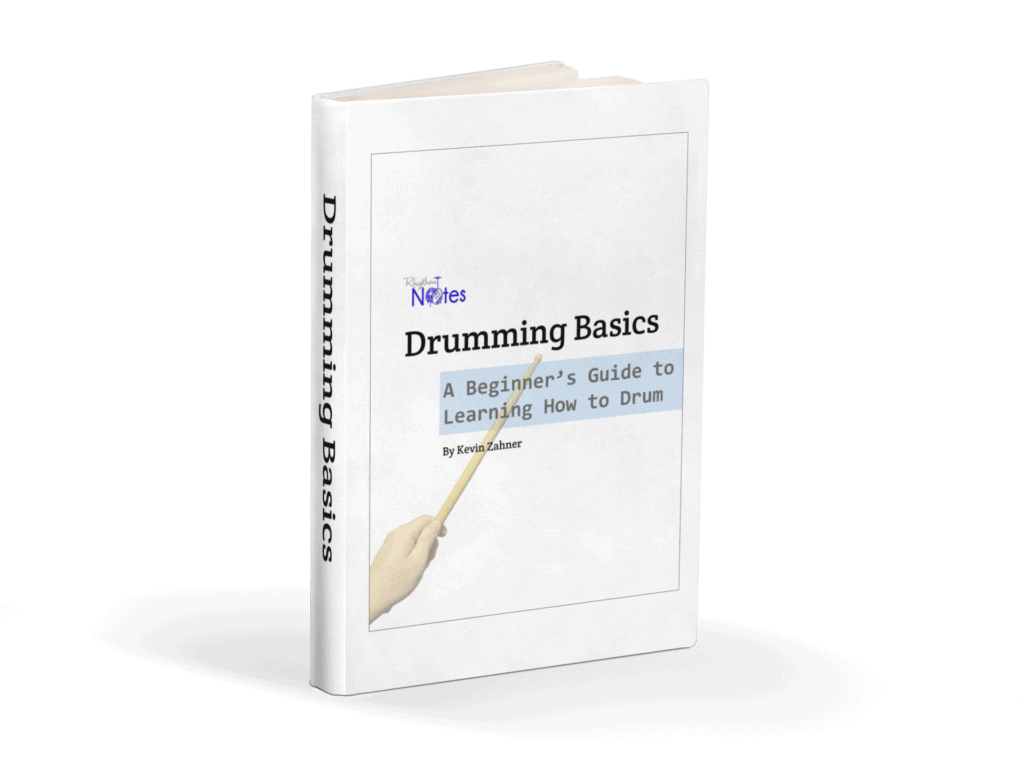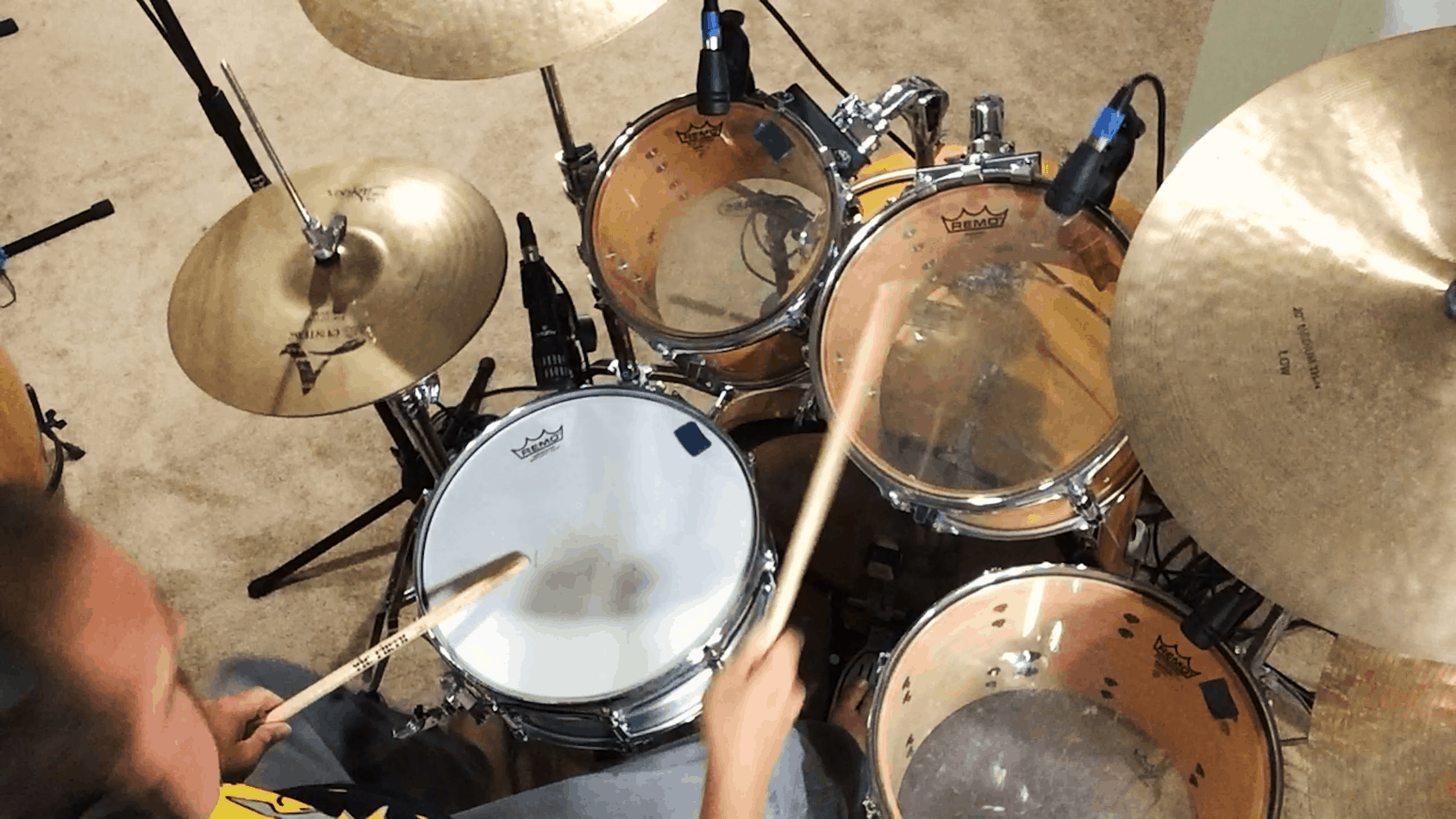All great drummers work on developing skills every day. It’s what makes them great. I’m talking about the things that establish the essential foundation for playing drums — the drumming basics.
The most essential drumming fundamentals are a cumulative list, starting with how you grip your stick and moving on to stroke technique and so on. Once you master holding the stick and making sounds with a reasonable level of control, the rest is building on that foundation.
In other words, this list is in no way comprehensive or in order of importance. Beyond the first couple of issues, you can reprioritize any of these items. For example, you may have a teacher who prioritizes hi-hat technique (7 on the list) over executing drum fills (6) or playing a basic beat. That’s totally cool.
Try prioritizing these drumming basics — as well as any others you may consider — to tailor your practice to your needs.
1. Drums, Cymbals, and Sticks
The drums, cymbals, and sticks themselves are obviously not skills, but managing your gear is. This includes choosing the right tools and how to take care of them.
The Drums
Drums are the easy part. You don’t need brand new drums or the top of the line to sound great. As long as the shells and rims are in good shape, you can put new heads on them and tune the drum to a desirable sound.
Cymbals
For beginners, the type of cymbal is more important than the quality. As long as you have a set of hi-hats and a ride cymbal, you’re in business to work on the drumming basics.
Drumsticks
Sticks are a whole other issue. You don’t want to play with juck sticks. Used sticks lack balance and can affect the feedback from the drum if they are broken in any way. So buy new sticks that are comfortable for and fit the application.
Different applications of drum sticks can include the differences between playing drum set or just snare drum. Snare drum sticks generally have a round tip to produce precise attacks on the drum and tend to be thicker than drum set sticks.

Drum set sticks attempt to accomodate the needs of a cymbal — providing more surface area on the tip for attack — and the roundness needed for playing drums. This is often achieved through an acorn-shaped tip.
2. Gripping the Stick
Your grip determines how well you control the drum stick. It’s a balance between gripping the stick enough to stop the stick from rebounding away from the instrument and being able to stop the stick from motion after an attack.
Gripping the stick comes in many forms. For drumming basics, I always suggest learning American grip, which is a type of matched grip. This means both hands will hold the drumstick the same way, as opposed to traditional grip.

The American grip combines the power of German grip and the finesse of French grip. The hand position is the difference among all three grips.
Regardless of the type of grip you use, they all require drummers to establish a good fulcrum. Follow these steps for your fulcrum.
- Divide the stick into thirds.
- Pinch the stick between the first and second third toward the butt of the stick.
- Wrap your fingers around the stick.

Get your copy today!
Buy on3. Stroke Technique
Most drumming consists of two strokes: rebound and controlled strokes. The rebound stroke allows the drumstick to bounce off the drum and return to the preparation stage of the stroke. Controlled strokes stop the drumstick from returning to the preparation stage, controlling the rebound generated by the stroke.
You are either letting the stick bounce or stopping the bounce. Almost all drumming can be broken down into these two simple decisions.
Rebound Strokes
Rebound strokes are great for building speed. This is especially true because practicing rebound strokes helps drummers focus on accuracy, relaxation, and the economy of motion.
- Accuracy – Focus on striking the drum so the tip hits the center. This will train your brain to play the area of the instrument that you want, making consistent sounds.
- Relaxation – It’s imperative to play with relaxed muscles. If you tense up too much, not only will you not develop your technique properly, you may injure your hands or arms. Breathing is key to relaxation. If your practice feels a lot like meditation, you’re on the right track, for sure.
- Economy of Motion – The rebound stroke starts with a preparation by raising the stick so it is perpendicular to the playing surface. The next movement is an acceleration of the stick toward the playing surface. The stroke is played with a wrist turn, and the wrist moves back to the preparation position, allowing the rebound to raise the stick up with the wrist.

Controlled Strokes
Controlled strokes follow almost the same motions and technique as the rebound stroke. The biggest difference is that the rebound is stopped, so the stick is not allowed to return to the preparation position of the stroke.

Related: Drum Techniques and Rudiments – A Guide to Great Hands
4. Basic Drum Beat
All I ever wanted to do was play a basic drum beat. It’s why a lot of drummers start developing the drumming basics — we want to play along to our favorite songs or jam with friends.
The basic drum beat below can be played with the cymbal pattern on a number of different instruments. Start with the hi-hat or ride cymbal, and move on to other timbres like a cowbell, tambourine, or the rim of the drum, to name a few examples.


Level up your beat game with 24 kick and snare variations with both one- and two-measure beats. You’ll get a PDF with the notation and a VIDEO with demonstrations at different tempos and follow along notation and visual beat counter.
Buy It NowRelated: Cowbell Song – 15 Drum Beats That Can’t Live Without It
5. Developing Rudiments
Rudiments are like a vocabulary for drummers. To master the drumming basics, developing your proficiency on the rudiments should be a priority.

Start with basic rudiments like open and closed rolls, as well as paradiddles and flams. It can get very complex very fast, so don’t over do it. Defining your two basic strokes is key to mastering the rudiments, so break down everything into combinations of rebound and controlled strokes to gain clarity.
Double Stroke Exercise – Drumming Basics
Double strokes consist of two rebound strokes in each hand. When they are played hand to hand, like in the second measure of the exercise below, it makes an open-stroke roll.

Open Roll Exercise – Drumming Basics
The open roll is sometimes notated with an additional line to indicate that the rhythm is 32nd notes if the hand-to-hand rhythm is 16th notes. The rolls in the exercise below are nine-stroke rolls.

Refer to the link above (under item 3 on this list) for more in depth explanation on rudiments and techniques. The article includes examples, exercises to develop rudiments, and videos with demonstrations and further explanations.
6. Executing Drum Fills
A lot of drummers get into playing drum set because it’s so cool, and drum fills are among the most satisfying things you can do. Playing single-stroke rolls around the toms and landing big ensemble hits with cymbals supported by the snare or kick drum are powerful. But let’s not get carried away.
The drumming basics require us to stay grounded while we stretch our legs a bit in the song. Try to avoid playing fills that are out of character for the style or the song. Also, avoid playing a fill satisfy your ego. Make about more than you. Make it about the music, of course.
Related: How to Play the Best Drum Fills
7. Hi-Hat Technique
Growing up a huge fan of Carter Beauford, I learned early in the development of my drumming basics that the hi-hat is very important. Some think it’s the most important instrument on the drum set.
Hi-hat technique should offer a wide range of motions that produce a variety of sounds. The technique should also compliment the other techniques we develop, such as the definition of accented and unaccented notes.
The drumming basic for hi-hat, in my opinion, defines accented notes as being played with the shoulder of the stick on the edge of the cymbals. The unaccepted notes are played with the tip of the stick on the top of the cymbal.
Related: 8 Hi-Hat Techniques for Getting Great Sounds
8. Ride Cymbal Technique
How you play the cymbal will determine how the cymbal sounds. Although there are many ways to play a ride cymbal for just as many reasons, for drumming basics, let’s stick to a French grip approach.
The French grip is easily identifiable by the fact that the thumb is on top of the stick. Although I suggest playing with American grip earlier in this list, when you move your arm to access the ride cymbal, pronating your wrist slightly allows for a more ergonomic approach.
Since your thumb is facing up, the wrist turn won’t be at the hinge where your hand meets your arm. It will be a rotation of the forearm that executes the stroke. Still let the stick rebound from the cymbal and use your fingers to control the stick to achieve desired results.
9. Kick Drum Technique
The two basic kick drum techniques are heel down or heel up. Heel down achieves power from the ankle movement and calf muscles. The heel up technique uses the whole leg to gain power from mass.
Some drummers go back and forth about which technique is better, but it’s important to develop both, especially if you’re working on the drumming basics. The nice thing about developing the heel down technique is the added power and control you gain when you raise your heel from the pedal board to add the mass of your leg to the stroke.
It’s not really different from raising your arm to add to the mass of a stroke played with your hands. This concept of raising your arm is seen in the Moeller Technique. Your kick drum technique can benefit from the wider range of control you get from using the heel down and up combined.
10. Reading Sheet Music
Reading sheet music can be daunting if you have no idea where to start. This is one of the easier drumming basics because it’s basically about symbols that represent different ways to divide the beat.
Although some people may be intimidated by reading music, the basics are easy if you can do simple fractions. For example, a common time measure is 4 beats. These beats can be represented by one whole note per measure, two half notes, four quarter notes, eight eighth notes, etc.

Learning to read sheet music is helpful because this skill opens up access to lots of great documented drum methods. It leaves the mysteries of your favorite drummers less to wonder when the performance is documented and exercises are provided to help you develop what it takes to play well, too.
Related: How to Read Drum Music – From Notes to Charts
11. Playing With a Metronome
Playing in time is a drumming basic that’s non-negotiable. It will never matter what you play if it’s not in time, and there’s no better tool than a metronome to help develop this skill.
Metronomes are an essential tool to use for any type of practice. Whether you are playing on a pad to develop stroke technique or playing drum beats to work on your groove, practicing with a metronome will help your internal clock become fine tuned.
Related: 4 Strategies for Drumming With a Metronome

12. Listening to Other Musicians
This includes listening to music in general with a critical ear. I’m not saying everything you hear needs to be evaluated and critiqued. A critical ear asks questions about how the players are making sounds, why the groove feels good, or whether the song is supported by what the drummer is doing.
It’s just about asking questions to try to understand the music so you can become just as critical about your own playing. It’s one of the best skills to develop and become a good player.
13. Stylistic Playing
We hear it all the time. “The drummer is the time-keeper.” In all fairness, the drummer is a time-keeper, just like the bass player, guitar, keys, and any other instrumentalist is a time-keeper. The drummer establishes style, as well.
Whether it’s a style of swing or an Afro-Cuban style, the drummer plays one of the largest roles in establishing style and feel. The feel of the groove ranges from more straight to more swung with varying degrees of each on a continuum. Developing control over the feel for different styles is a crucial skill for drummers to develop.
Styles on drum set are often adaptations of traditional rhythms unless the style was developed in ensembles that include drum set, like reggae. That’s why it’s so important to know and understand the traditional rhythms to be able to play the essential parts on a drum set.
Rhythm Notes has a lot of lessons with videos on different styles, so check out this list of articles.
14. Improvising
Drum solos are one of the funnest things to do on a drum set. It’s your time to shine and show off a little skill while developing something musical on your instrument.
Although there are no rules for improvising on drums, some strategies work better than others. For example, consider the following tips for developing a drum solo.
- Be patient – Not every minute of your solo needs to be the most interesting thing you’ve ever played. Chip away at beats in each measure until you piece together some ideas you want to develop.
- Use themes – Once you have ideas to develop, shape them into themes that can be played on various instruments. Then, come up with variations on the theme to continue the solo development.
- Apply rudiments – Remember your drum vocabulary. Use the rudiments like rolls to create interest through note duration or paradiddles to access different instruments through the sticking combinations.
- Leave space – This goes along with being patient. The empty space, when used strategically, can make the busier stuff seem more exciting.
- Create energy – The contrast between busy and conservative playing can create energy, and it can be created also through tempo and dynamics.
- Use dynamics – Not everything needs to be super loud and in your face. Bringing the dynamics up and down at key phrase markers in your solo can add to the energy and excite very easily.
- Establish a form – Take listeners on a journey. It can go up and down, fast and slow, and around each corner can peak through a lick or interesting fill.
- Include grooves – Some of the best drum solos start with a groove and fills start to transform the groove into new grooves or increasingly complex fills. Some solos simply play licks over a steady kick drum beat. This is totally cool and should be explored along with other ostinatos (repetitive rhythms).
15. Balancing Your Sound
Learning to play drums is a lot to think about when you first start. Most drummers pay little attention to how loud they are playing the cymbals in relation to the drums. But it’s one of the most crucial drumming basics on this list.
Try playing the basic drum beat with the cymbals quieter than the drums. Be sure to not lose tempo or intensity when you change the volume of the instruments. Repeat this exercise with the kick drum and snare.
Focusing on the different instruments and volumes will help train your hands and feet to respond to musical situations more appropriately. For example, if you are aware of your own dynamics for each instrument, you’ll be able to respond to dynamic changes with other players.
The skill of balancing your sound translates very well in a recording studio. Drummers who have a well balanced sound among all of the drum set instruments generally make better drum tracks for songs. Plus, if you have a limited amount of microphones for the session, a balanced drummer will still sound great.
Final Thoughts
The drumming basics are fundamental. This means drummers never stop working on them. As you get better on the instrument, your attention will shift to specific improvements and exploring new contexts, but we never stop working on strokes, drum beats, and balancing our sound.


